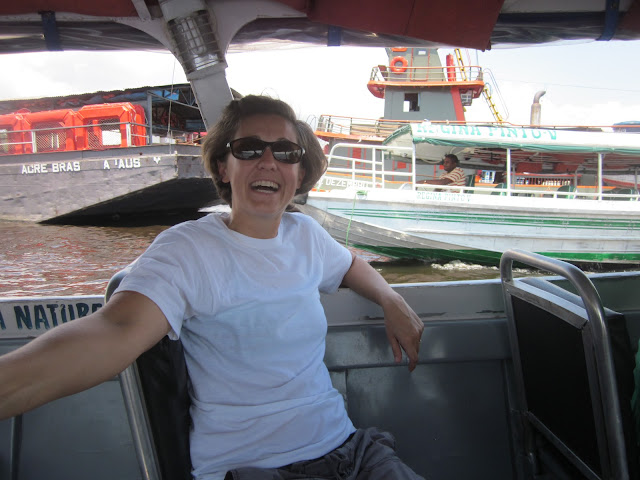Okay, took me a while to get over the bug bites (bedbugs, ticks, mosquitos and other bugs we're not that familiar with). But I'm back now to show you our trip to the Amazon! I have a few things that I'm going to do specific blog posts on (like Brazil nuts!), but right now I'm going to give you the basic trip overview.
The days we were gone I had the good ole internet posting our itinerary for me, so you probably know what we were up to. If you don't, just look back a few posts, it should be there. While I was in the states for a month, dear ole Toby got to looking on the internet and found us an Amazonian survival vacation. When we lived in the US I was really interested in foraging. You know, finding your food other places than the grocery store. It was a fun challenge there, finding dandelions on the side of the road, random fruit and nut trees around the city. Edible things were hard to come by in Atlanta, it seemed. Well here it's not that exciting. Food grows EVERYWHERE! There are probably 50 mango trees in a three block radius. And nut trees, banana, coconut, fish in the front yard. Food is plentiful here. So I've given up on foraging. Sort of. It's also harder to explain why you are trying to climb your neighbor's tree (I just want to borrow your mangos!) when you don't speak the language that well. I kept thinking, 'just do it! You'll seem like a charming American!'. But I'm not sure that charming is the most common way to describe Americans, so I haven't climbed anyone's trees yet.
But back to the subject. Our Amazonian expedition was a survival trip, we were supposed to catch and find all of our food, trek through the jungle, etc. Below are the first group of pictures.
So the people we did the tour with suggested no more than 20kg per person. We probably had 20 kg total. We were supposed to be trekking through the jungle the whole time, so we figured the less we packed, the less we had to carry. We ended up being really happy with what we packed, because when we did trek through the jungle we also had to carry our two hammocks. Everything we brought on the trip fit into the green waterproof bag on the bottom left of the photo. Everything we took when we trekked, including the two hammocks, fit into that bag, so we really brought almost nothing.
So I know you're not supposed to use too many boats and cars and planes when you're trying to be eco friendly while traveling. We used a lot of these things. But I think we offset it by our choice of stay. We took a car to our airport, flew from Recife to Brasilia, to Manaus. Took a van to a boat, the boat to another van, that van to yet another boat which took us to the lodge.
Our guide said that the in the Manaus region the waterway is much more of a road than the actual roads. People use boats more often for transportation than cars. As seen here, a floating gas station. How neat! There were a ton of boats where we got on our first one. It's the meeting of the Rio Negro and Rio Amazon, so it was a big port area.
Also home to the famous meeting of the waters. The Rio Negro is darker, coming from a totally different area than the Amazon. It's color is made up of decomposing plants. Along with being darker, it's also cooler and slower. The Amazon river is composed of silt and runoff from...Peru? Shoot. I forgot the country. Anyway, it's made of runoff from the mountain ranges to the West. It is lighter in color, warmer and faster running. Because of all of these factors, when the two rivers meet they don't combine completely for about 15 km. It was really impressive to see in person.
For Toby's birthday my Dad got him a water filter for this trip. We tried it out at the meeting of the waters. It works great, if any of you are in the market for a water filter I recommend this one. Of course, where we tried it out was a really busy area, so our water still tasted a bit oily. But other than that, great! No...bathroom issues.
We came in the driest part of the dry season. This means that the boat above is normally covered by 20 feet of water. And the first little pitstop we came to was completely built on really rickety stilts. It looked like something out of a movie set.
This is where we caught our second boat. The little floating house below comes all the way up to where I took the photo from, in the rainy season.
Haha, the steps were so far from each other. Pay attention!
Lots of these floating houses were just floating on old logs. Much cooler in person.
Oh and a fun fact. Amazonas (the Brazilian state) is the 9th largest country subdivision (more or less that means states) in the world. For you USA'ers, a good reference is Alaska. It's number 7 on that list. So Amazonas is big. Big ole big.


















No comments:
Post a Comment